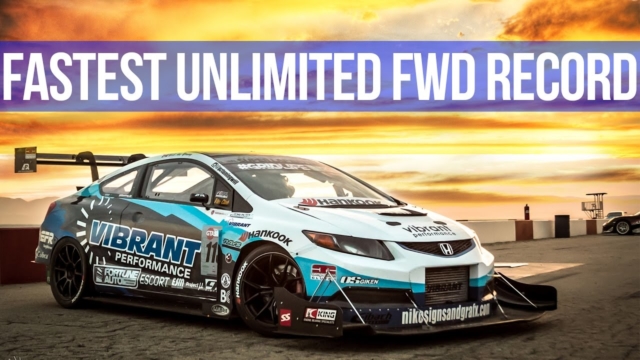Two very different cars intended for racing the clock are brought together here through one common trait: they’re both driven by drifters. Take one Nissan 350Z, drop in a mildly-fettled LS3, and park it on the grid next to a turbocharged Civic—which boasts an absurd 771 horsepower and a scarcely contained 520 lb-ft of torque. What happens when two avid Formula D competitors strap into the aforementioned cars and try to trace tidy lines, avoid wheelspin, and set a quick lap?
In the Pink Corner: The “LS350Z”
Time trials and drifting go hand-in-hand, but the disciplines are as different as the spec of these two ferocious builds. The 350Z, owned by model/racer Savannah Little, is about as far from stock one can get before changing the suspension geometry and mounting the motor behind the driver. The Z is no slouch from the factory, but Little felt in need of more power—in the form of an all-american aluminum brute.
With the help of ISR Performance’s swap kit, installing the LS3 wasn’t a real knuckle-buster. It mates up to the factory Z gearbox, albeit with a custom Exedy flywheel and a tailored driveshaft courtesy of The Driveshaft Shop. One upside of running an LS3 is it’s quite short—shorter than the VQ35—and therefore can be mounted five inches further towards the rear. This makes the car quite lively, though, and you can see Little is somewhat tentative getting on the throttle.
https://
The movement back towards the rear is led by ISR Performance’s prototype long tube headers, which mate up with the Z’s Y-Pipe, allowing the use of just about any catback 350Z exhaust, and ends up at a OS Giken differential to neatly deploy 505 horsepower and 500 lb-ft at the wheels. Best of all, it’s helped bring the Z’s weight down to 3,022 pounds with driver and a full tank, and with a cross weight at 50.2% with no corner balancing adjustments!
That power is sent to the ground via Konig Hypergram wheels wrapped in Maxxis Victra RC-1 tires measuring 10.5″ across. The square setup gives the car a very neutral feeling with a slight edge towards oversteer. Inboard, SPL front upper control arms, tie rods, end links, bushings, rear camber arms, rear traction and toe arms complement Fortune Auto Dreadnought coilovers and Wilwood Superlite brakes. As mentioned earlier, this car has everything thrown at it short of new geometry and serious aero package.
It’s an agile handful, but it’s also well-balanced and capable of some impressive mid-corner speeds. Traction might be an issue—but with the linear power delivery, it might best the Civic in that department. Nevertheless, it has its work cut out as it has to battle a nimble, aero-laden, powerful Civic that has a definite advantage—on paper at least.
In the Blue Corner: A Study in Excess
Will Au-Yeung’s Civic is a very different machine altogether; lighter, shorter, more powerful, and yet somewhat handicapped by its layout. The K24A2 motor is built and force-fed by a Borg-Warner EFR 9174 turbocharger. CP pistons, Brian Crower rods and cams, a Skunk2 intake. With the snail cranked, it’s hard to fathom just two wheels harnessing all that power—in enters the Hondata ECU and traction control system. A massive front splitter and a reactive LSD from OS Giken—which locks up during acceleration and briefly under braking for stability. It’s a neat piece of kit, but driving 700 peaky horsepower through two wheels is a tall order.
This car wears spherical bearings, Dreadnought coilovers, and RAYS Gram Lights 57FXX in 18×10.5-inch front and 18×9.5-inch rear wrapped in Hoosier A7 slicks. The footwork and the aerodynamic grip provide the sort of roadholding you’d want from a 700-horsepower machine, but is it well-balanced enough to match the sorted Nissan, or is it a case of overkill?
Dueling Drifters
Naturally, the pointy Z takes the lead in the tighter beginnings of Gingerman Raceway. However, that willingness to rotate comes at the expense of corner-exit speeds; Geoff Stoneback reverts to his old habits and puts the car into one-too-many slides. It’s a car that takes some finesse, as it looks like it’s up on its tiptoes most of the time. He can claw back slightly in the tightening, point-and-squirt sections, but spends a lot of time off-throttle in the faster sweepers.
In contrast, Matt Powers, with his beach-bum insouciance, seems to take a more relaxed approach to throttle application. He puts the power down quite neatly, and streaks ahead once the two tread on a longish straight. Power is his main advantage here—as powers never really stretches a lead in the tighter corners. In the latter third of the course, Powers can put the turbocharged grunt to the ground with ease; the final straight helps separate the two competitors by five car lengths.
In any event, it’s a commendable attempt by two drifters slightly out of their element. With more experience, this sort of duel would be nail-biting. Let’s hope it convinced some drifters to try their hands at time attack.























